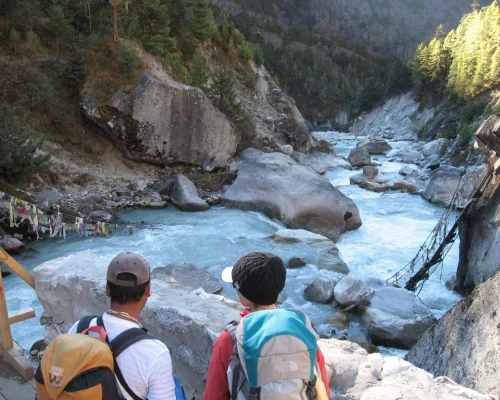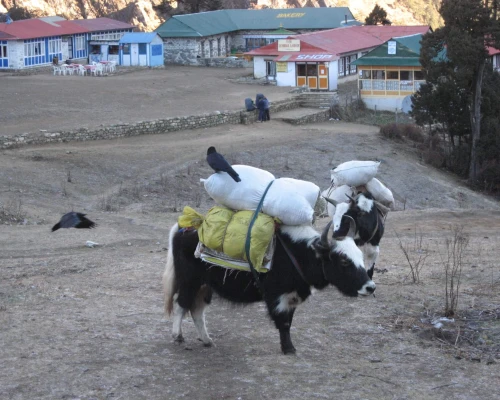Tengboche Trek begins with a regular flight from Kathmandu to Lukla. From Lukla, the trekking route proceeds towards Phakding on the same day. The following day, you continue trekking to Namche Bazaar, where you spend the night. Moving forward, the trek takes you to Khumjung, and on a subsequent day, you head towards Tengboche to explore the area.
While exploring Tengboche, you'll have the opportunity to visit the renowned Tengboche Monastery and observe its ancient statues, paintings, and scriptures. The area also offers breathtaking views of majestic mountain peaks such as Mount Everest, Nuptse, Lhotse, Thamserku, and Ama Dablam. Additionally, you can immerse yourself in the natural surroundings, including rivers, flora, and fauna. Interacting with the local Sherpa people in the villages adds a cultural touch to your experience.
The next day, a helicopter will take you to Kala Patthar, where you'll have a brief landing to enjoy the stunning views of the mountain peaks and their surroundings. After a short exploration, the helicopter will bring you back to Lukla. With extra time in Lukla, you can explore the local markets or opt for short hikes. In the evening, you can savor Nepalese or foreign cuisine and spend the night there. On the final day, you'll take a regular aircraft flight back to Kathmandu. Throughout your journey, you will have the chance to witness the awe-inspiring views of mountains, visit famous monasteries and temples, traverse through lush green forests adorned with pine, oak, and blooming rhododendron trees, and immerse yourself in the cultural ambiance of the villages along the route.
Indulge in the serene ambiance of nature and witness the panoramic view of Mount Everest.
- Visit UNESCO World Heritage sites in Kathmandu, including Kathmandu Durbar Square, Pashupatinath temple, and Boudhanath Stupa.
- This trek is a great opportunity to learn about Sherpa culture and heritage, experience the beauty of the Khumbu region, and challenge you physically and mentally.
- Trek through the subalpine flora of Sagarmatha National Park, home to rare animals such as Musk Deer, Himalayan tahr, and Blood Pheasant.
- Enjoy panoramic views of Mt. Everest, Lhotse, Nuptse, Thamserku, and Ama Dablam from Namche viewpoint.
- Explore the monastery's monuments, statues, paintings, and scriptures to learn about Sherpa culture and heritage.
- Intermingle with the Sherpa people in the villages of Phakding, Tengboche, and Monjo.
- Visit Tengboche Monastery, the largest monastery in the Khumbu region of Nepal.
- Embarking on a Ten-day trek in the Everest region provides an incredible opportunity to witness the breathtaking views of some of the world's highest peaks, including Mt. Everest, Nuptse, Lhotse, Ama Dablam, and Thamserku. Each day of the trek presents new vistas and unforgettable experiences.
Tenboche Trek Overview
Tengboche Trek is an ideal choice for those with limited time or who prefer not to trek all the way to Everest Base Camp. Despite its shorter duration, it offers a wonderful glimpse into the lives of the local people in the Everest region, while providing stunning views of Mount Everest and the surrounding mountains. The trek is less strenuous than other routes, with walking hours averaging around 5-7 hours per day, and maximum altitudes not exceeding 4,000 meters. This makes it a suitable option for individuals with average fitness levels. The journey begins and ends with a flight to/from Lukla Airport.
The trek follows a route through alpine forests and captivating villages along the Dudh Koshi and Bhote Koshi rivers, eventually leading to Namche Bazaar, a bustling market town. Namche serves as the gateway to Sagarmatha National Park, a protected area known for its diverse wildlife, including the elusive snow leopard and red panda. The region's ecological significance has earned it a place in the Sacred Himalayan Landscape initiative by the World Wildlife Fund.
In Namche Bazaar, visitors can witness the Sherpa people going about their daily lives, observe other trekking and mountaineering groups preparing for their expeditions, access internet services, enjoy quality coffee, and dine in excellent restaurants. From Namche, it is possible to take a short trek to Khumjung Village and visit the school established by Sir Edmund Hillary, who successfully summited Mount Everest in 1953. The school stands as a testament to Sir Edmund's contribution to the Sherpa community, which remains an integral part of Everest expeditions. It is even possible to encounter the sons of Sir Edmund and Tenzing Norgay Sherpa, who continue to lead trekking groups in the area.
A major highlight of the Tengboche Trek is a visit to Tengboche Monastery, the largest monastery in the Khumbu Region, situated at an elevation of 3,867 meters. Although it suffered extensive damage during the 2015 earthquakes, the monastery still offers breathtaking panoramic views of Mount Everest, Nuptse, Lhotse, Ama Dablam, and Thamserku. The choice of this location for the monastery's construction is easily understood when surrounded by such natural beauty and spiritual significance. Interestingly, Mount Everest is referred to as Chomolungma, or Mother Goddess of the Universe in both Tibetan and Sherpa cultures. This adds to the allure of the region, as it has long attracted people seeking both natural and spiritual inspiration.
In summary, the Tengboche Trek is a perfect opportunity to immerse oneself in the sights and sounds of the Khumbu Region and Mount Everest without the physically demanding ascents and descents of other treks in the area. However, it's important to note that this is still the Everest Region, and the trek requires proper preparation and respect for the challenging terrain. For those unable to undertake the trek, helicopter tours to Everest are available as an alternative.
Tengboche Monastry Trek Route
The Tengboche Monastery Trek begins with a captivating flight to Lukla, which serves as the gateway to the Solukhumbu Region. This region is renowned for its Sherpa villages and monasteries and its close proximity to the world's highest mountain. Lukla is home to numerous Sherpas and trekking porters. The trek continues through a charming village bustling with local people, horses, donkeys, trekkers, and porters. Eventually, the day concludes at the bank of the Dudh Koshi River along the Tengboche Monastery Trek.
Ascending to the picturesque village of Namche Bazaar provides breathtaking views. The journey takes you through the lush vegetation of Sagarmatha National Park, which is abundant with wildlife, pine forests, and beautiful rhododendron flowers. Throughout the trek, you will have ample opportunities to interact with the Sherpas and immerse yourself in their rich traditional lifestyle. Following a high-altitude route, the trek offers the first magnificent view of Everest as you progress towards Tengboche Monastery and Khumjung Village. The monastery's serene atmosphere and dramatic ambiance instill a sense of tranquility, reinforcing your faith in the divine. This experience also provides an immersive encounter with Tibetan Buddhist culture, which is deeply practiced in this region.
Tengboche Trek Difficulty
The Tengboche Trek is a suitable option for both novice and elderly trekkers, indicating that it is not an overly challenging trek. It is particularly favored by novice trekkers due to its manageable walking days and breathtaking views of the magnificent mountains. The Tengboche Trek is often described as magical and achievable for trekkers of all skill levels who wish to experience the splendor of the mountains. Therefore, the Everest Panorama Trek can be considered relatively easy in terms of difficulty, with the primary concern being the risk of altitude sickness, which can be addressed with appropriate measures.
Best Season to Tengboche Trek
The choice of season greatly influences the overall experience of the Everest Tengboche Trek. The best seasons for this trek are generally considered to be spring (February to March) and autumn (September to December). During these seasons, the weather is relatively stable, with clear skies and pleasant temperatures, making it ideal for trekking. The views of the mountains are also exceptionally stunning during these periods.
However, it is not compulsory to undertake the journey only during these seasons. The trek can also be enjoyed during the monsoon season (June to August) and winter (December to February). It's important to note that trekking during the monsoon season can be challenging due to heavy rainfall, muddy trails, and limited visibility. Winter trekking requires more preparation as temperatures can drop significantly, and there may be snowfall in higher elevations.
Regardless of the season chosen, it is essential to be well-prepared and equipped for the specific weather conditions and challenges that come with each season. It is also advisable to check the weather forecasts and consult with local guides or trekking agencies for the most up-to-date information and recommendations for the chosen season.
Why Nepal Nomad Trek to Tengboche Monastry
For over two decades, Nepal Nomad has been dedicated to fulfilling the desires and expectations of adventure seekers in trekking, climbing, and travel in general. Our team consists of experienced and professional guides and porters who possess expertise in evacuation procedures, map-reading, and first-aid services. We take pride in the fact that our efforts have resulted in numerous travel stories and the satisfaction of nomads from all corners of the globe who have chosen to explore with us. We are delighted to offer you the Everest Tengboche Trek, a journey that can be customized to suit your preferences. Our aim is to assist you throughout the process and address any concerns or uncertainties you may have regarding trekking in Nepal. It would be our honor to provide you with a memorable experience and ensure that all your needs are met.






